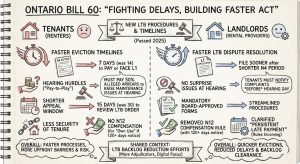Ending a tenancy early in Ontario can be stressful, especially when life changes unexpectedly. Whether a tenant needs to move for a new job or a landlord must regain possession of their property, understanding how to end a lease legally is crucial. The rules under Ontario’s Residential Tenancies Act (RTA) outline clear procedures for both fixed-term and month-to-month agreements, but many people are unsure about their rights or the proper forms to use. Failing to follow these steps can lead to unnecessary disputes before the Landlord and Tenant Board (LTB). Familiarity with the rental laws in ontario is essential for navigating this process effectively.
That is where Found Spaces can help. The platform offers practical guidance, trusted resources, and expert insights to make the process easier for both tenants and landlords. By understanding your obligations and communicating clearly, you can avoid conflict and end your tenancy on the right terms. Knowing the rental laws in ontario can help both tenants and landlords avoid common pitfalls.
Understanding Tenancy Types in Ontario
In Ontario, knowing the type of tenancy agreement you have is crucial for both landlords and tenants. There are mainly two types: fixed-term leases and month-to-month agreements. Fixed-term leases last for a set duration, like one year, and typically end without automatic renewal unless both parties agree otherwise. On the other hand, month-to-month agreements continue until either party gives notice to terminate, usually requiring 60 days’ written notice. This flexibility allows tenants and landlords to navigate changing circumstances more easily.
Understanding the type of tenancy helps determine the necessary notice period and valid grounds for ending the lease. For example, if a tenant is in a fixed-term lease, they may need valid reasons under the Residential Tenancies Act (RTA) to break the lease early, such as landlord violations. It’s also essential for tenants to review their lease agreements carefully, as some may include specific clauses about early termination or potential penalties.
Landlords also have responsibilities, like maintaining the property, which can influence the type of tenancy and the termination process. Additionally, both parties should be aware of any rent control regulations that might affect their rights. Negotiating terms that suit both needs is possible, but any changes should be documented in writing to avoid future disputes. Overall, familiarity with tenancy types empowers both landlords and tenants to make informed choices.
How Tenants Can End a Tenancy Early in Ontario

Tenants in Ontario have specific rights under the Residential Tenancies Act (RTA) that allow them to end a tenancy before the lease term is over. However, early termination must follow the correct legal steps to avoid penalties or disputes.
The first step is to provide written notice to the landlord within the required time frame. In many cases, both parties can agree to end the tenancy using the N11 form, which formalizes a mutual termination and helps prevent misunderstandings.
Tenants facing domestic violence or abuse can legally terminate their lease under special RTA provisions designed to protect their safety. Another option is subletting the rental unit, but this requires the landlord’s written consent. Subletting allows tenants to find a suitable replacement without fully breaking the lease.
If a landlord fails to meet essential obligations, such as maintenance, repairs, or providing vital services, tenants have the right to end the tenancy early. Keeping detailed records of all communications, repair requests, and notices is important for protection in case of a dispute before the Landlord and Tenant Board (LTB).
Each termination reason comes with different notice periods, so it is essential for tenants to understand the specific timelines that apply to their situation. For those uncertain about their rights or forms, Found Spaces provides clear guidance and practical tools to help tenants navigate early termination confidently and stay compliant with Ontario rental laws.
Legitimate Reasons for Tenants to Terminate a Lease

Under Ontario’s Residential Tenancies Act (RTA), tenants have several legitimate reasons to end a lease early without facing penalties. These legal protections ensure that tenants can adapt to changing personal or living circumstances while maintaining compliance with rental laws.
One of the most important protections is for tenants experiencing domestic violence or abuse. By submitting Form N15, tenants can end their lease within 28 days, prioritizing safety above all else. Another valid reason is when a rental unit becomes uninhabitable due to serious neglect or damage. If the landlord fails to complete necessary repairs or maintain safe living conditions, tenants may legally terminate the lease after proper documentation and notice.
Tenants may also end a lease early if the landlord breaches the agreement, such as failing to provide essential services or violating privacy. In these cases, tenants can apply to the Landlord and Tenant Board (LTB) for approval.
Other legitimate grounds include:
- Health concerns that require relocation for treatment or safety
- Job relocation to another city or province
- Harassment or illegal activity occurring within the rental property
- Moving into a long-term care facility for medical or personal needs
In every situation, tenants should maintain clear documentation such as medical records, relocation letters, or police reports. Proper written notice ensures compliance and helps avoid disputes.
For tenants uncertain about their rights or the required forms, Found Spaces provides reliable guidance, access to official documentation, and easy-to-follow resources that simplify Ontario’s rental laws.
When Landlords Can End a Tenancy Early
Landlords in Ontario have specific situations where they can end a tenancy early, and it is crucial they follow the rules set by the Residential Tenancies Act (RTA). One common reason is non-payment of rent. In such cases, a landlord can issue a notice using Form N4, which requires tenants to pay their rent within a certain time frame or face termination.
If a tenant causes serious damage to the property or engages in illegal activities, landlords can use Forms N5 or N6 to terminate the lease. These forms allow landlords to act quickly when the situation is severe, ensuring that the property and other tenants are protected.
When landlords need the rental unit for personal use, they must provide at least 60 days’ notice using Form N12. This is often necessary when a landlord wants to move in themselves or have a family member occupy the unit. For substantial renovations that require the property to be vacant, landlords must use Form N13 and give at least 120 days’ notice. This ensures that tenants have adequate time to find new housing.
It is essential for landlords to observe the notice periods specified in the RTA to prevent disputes with tenants. If a tenant is involved in illegal activities, landlords can act swiftly, but they must still document the situation properly. Good communication and record-keeping are vital, as they help support the landlord’s case if any disputes arise. Understanding these legal grounds for termination not only helps landlords navigate the process smoothly but also shields them from potential counterclaims by tenants.
Valid Grounds for Landlords to Terminate a Lease
Landlords in Ontario must follow specific legal grounds to terminate a lease. One of the most common reasons is non-payment of rent. When tenants fail to pay rent, landlords can use Form N4 to initiate termination. This requires providing proper notice, as outlined in the Residential Tenancies Act (RTA).
Illegal activities or significant damage to the property also justify immediate termination. In these cases, landlords can use Form N5 for interference or Form N6 for illegal acts. Such severe breaches allow landlords to act swiftly, protecting their property and other tenants.
If a landlord needs the unit for personal use, they must clearly state this intention and provide at least 60 days’ notice using Form N12. Similarly, when planning renovations or demolition, landlords must give adequate notice, typically 120 days, to ensure tenants have ample time to find new housing.
Another valid ground is the landlord’s failure to maintain the property. If a landlord neglects their obligations, tenants can apply for early termination through the LTB.
Before proceeding with termination, landlords should carefully assess the situation to avoid legal issues. Documentation of the reasons for termination is critical in case disputes arise at the LTB. Understanding the specific grounds provided by the RTA helps landlords navigate this process effectively, ensuring they follow all legal requirements to prevent claims of wrongful eviction. Consulting with legal professionals can further clarify a landlord’s rights and responsibilities.
Exploring the N11 Agreement for Mutual Consent

The N11 form is a simple yet powerful tool for landlords and tenants looking to end a lease together. By signing this mutual agreement, both parties confirm their consent to terminate the tenancy, making it clear that they are on the same page. One of the advantages of the N11 form is that it does not require a specific reason for the termination, which allows for flexibility in various situations. When filling out the form, it is essential to specify the termination date and any conditions both parties agree upon, as this helps prevent misunderstandings later.
Proper documentation is crucial. If either the landlord or tenant fails to uphold the terms of the N11 agreement, disputes may arise that could complicate the process. Therefore, both parties should keep signed copies of the agreement for their records. Clear communication during this process is vital to ensure that all terms are understood and accepted, reducing the risk of future conflicts.
To make the process even easier, Found Spaces offers templates and guidance for completing the N11 form effectively. Utilizing this resource can help streamline the termination process, making it smoother for everyone involved.
Consequences of Leaving Without Proper Notice
Leaving a rental property without providing proper written notice can have serious consequences for tenants. Even after moving out, the tenant may still be liable for rent payments until the lease officially ends or until the landlord finds a new tenant.
Under the Residential Tenancies Act (RTA), landlords must make reasonable efforts to re-rent the unit, but if they cannot find a replacement quickly, the former tenant may remain responsible for unpaid rent. In some cases, landlords may deduct unpaid amounts or repair costs from the security deposit.
Failing to follow proper termination procedures can also affect future rental applications, as landlords may report the issue to references or credit agencies. Additionally, a landlord may pursue legal action for unpaid rent or damages through the Landlord and Tenant Board (LTB).
To protect themselves, tenants should always provide written notice, document move-out dates, and maintain copies of all correspondence.
If you are unsure about how to give proper notice or which forms to use, Found Spaces can help. The platform offers trusted resources, form templates, and guidance to ensure tenants end their lease properly and avoid unnecessary costs or disputes.
End Your Tenancy the Right Way with Found Spaces
Ending a tenancy early in Ontario does not have to be stressful or confusing. With the right guidance and understanding of the Residential Tenancies Act (RTA), both tenants and landlords can protect their rights, avoid costly disputes, and complete the process legally. Whether you are navigating a job relocation, domestic safety concerns, or property management issues, having access to trusted information makes all the difference.
Found Spaces provides the clarity and confidence you need to handle early lease terminations correctly. From easy-to-understand legal resources to form templates and expert insights, the platform empowers both landlords and tenants to make informed decisions.
Take the next step toward resolving your tenancy issues smoothly and legally. Book a call with Found Spaces today to get personalized support and ensure your lease termination is handled the right way.

Frequently Asked Questions
1. What are the common reasons for ending a tenancy early in Ontario?
Common reasons for ending a tenancy early in Ontario include personal circumstances like needing to move for work or school, financial difficulties, or issues with the rental property that the landlord hasn’t fixed.
2. How does a tenant inform the landlord about leaving early?
A tenant should give written notice to the landlord, typically 30 days in advance, depending on the lease agreement. It’s best to check the specific terms of the lease.
3. Can a landlord refuse a tenant’s request to end the tenancy early?
Yes, a landlord can refuse if the tenant doesn’t follow the proper procedures or if the reason for leaving does not comply with the rules in Ontario.
4. What happens to the security deposit if a tenant ends the lease early?
If a tenant ends the lease early, the security deposit may be returned based on the condition of the rental unit, and any outstanding rent or damages may be deducted.
5. Are there penalties for breaking a lease early in Ontario?
Yes, there can be penalties, like paying rent until a new tenant is found, but the specifics depend on the lease agreement and local laws.
TL;DR In Ontario, landlords and tenants must understand the rules for ending a tenancy early. Tenants can terminate leases for reasons like mutual agreement, safety concerns, or landlord breaches by providing written notice. Landlords can end tenancies for non-payment, serious damage, personal use, or renovations with proper notice. The N11 form allows for a mutual termination agreement, but departing without notice can result in financial penalties. Clear communication and documentation are essential for both parties to navigate this process successfully.




